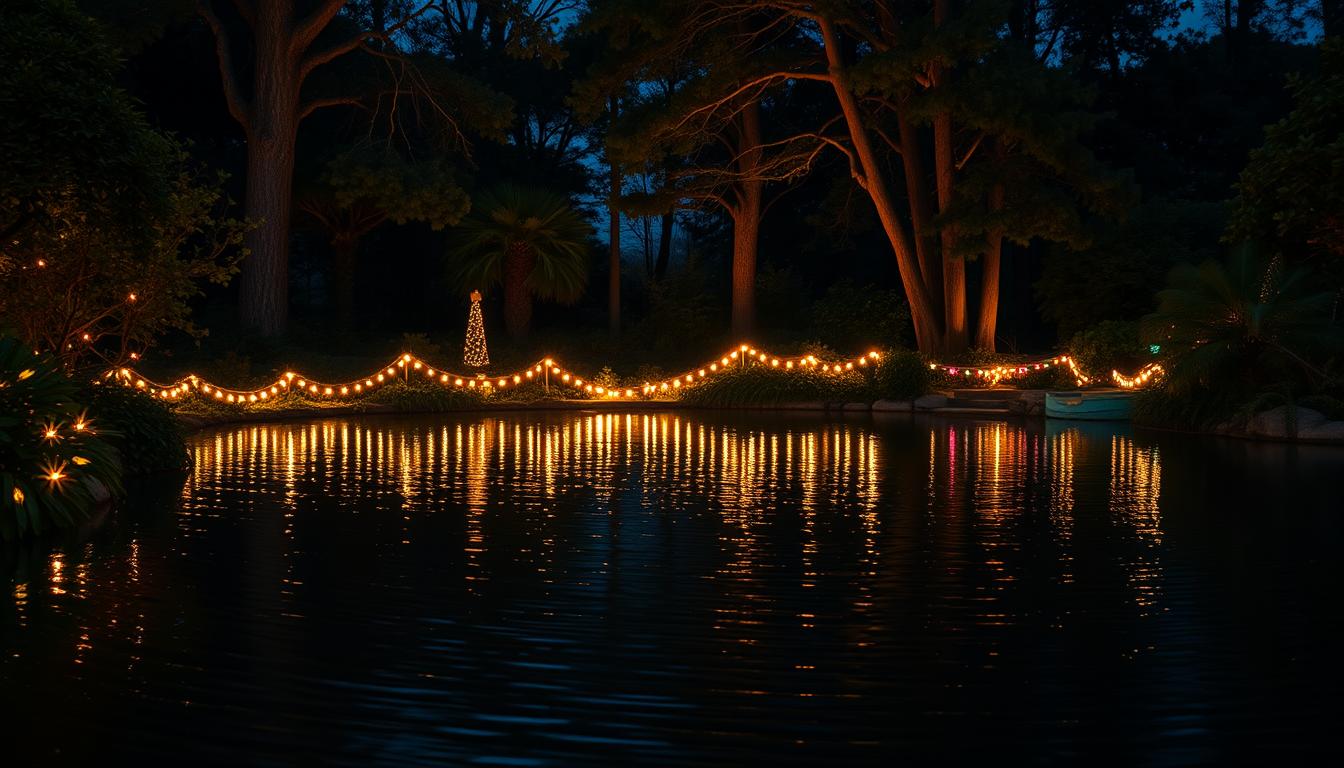
Ready to brighten your yard without risk? This guide introduces smart, safe ways to add light around a small water feature at home. We focus on LED solutions sized for outdoor use and designed to improve your night experience.
You’ll find clear advice on product choices: submersible fixtures, floating displays, and shoreline lights. We explain how led lights cut energy use and run cool, so they last longer and cost less to operate nightly.
Learn simple design tips to highlight natural contours and reduce glare. The write-up also covers safety essentials — proper fixtures, power planning, and protective gear — so your display looks great and stays reliable.
By the end, you’ll have a shortlist of reliable products and a step-by-step path from idea to installation. Expect practical, compact recommendations that balance festive impact with easy maintenance.
Key Takeaways
- Choose LED fixtures for long life and low heat.
- Match product type to still or moving water and depth.
- Use shoreline and submersible options to reduce glare.
- Plan power and protection for safe outdoor operation.
- Prioritize durable, weather-rated products like Philips or GE.
Safely Lighting Ponds and Water Features for the Holidays
Start with safety: low-voltage systems and sealed fixtures should anchor every plan near water. Keep cables raised or routed through protective conduits and run everything from a GFCI-protected circuit to reduce shock risk.

Safety-first principles for outdoor, water-adjacent lighting
Mount or place fixtures with robust seals and weather ratings. Keep drivers and adapters off the ground and sheltered from splash. Add drip loops and strain relief to all cords.
Planning your design: colors, landscape, and nighttime visibility
Layer light on edges, plants, and focal features so the water reads clearly at night. Aim beams to minimize glare on the surface and avoid shining toward neighbors or footpaths.
- Choose fixtures that match depth and current: sub-waterline grazing for rocks and plants works well.
- Map color choices: one accent color or a restrained mix keeps the scene natural and readable.
- Test at dusk and refine positions to reduce reflections and improve sightlines along paths and decks.
Document your plan—runs, connections, and fixture specs—so maintenance and future upgrades stay safe and simple.
Best holiday lighting pond products to buy now
Good results begin with the right led products — from submersible fixtures to floating statement pieces. Start by matching fixture type to depth and motion. Submersible led light kits from suppliers like Reinders offer a broad variety of outputs, wattages, and materials so you can filter by wattage or finish.

Submersible kits and floating centerpieces
Submersible led light kits suit fountains and deeper shelves; pick corrosion-resistant housings and IP-rated seals. For dramatic scale, Everblue’s Vanguard Floating LED Christmas Tree is a ready-made showpiece: about 12 ft diameter, expandable 14–22 ft height, ~4,000 LEDs, under 200 watts, and listed at $3,595.50 with US warranties.
Surface, RGB systems, and power gear
Surface-mounted shoreline fixtures define edges and protect the landscape from glare. RGB color-changing systems add dynamic scenes when paired with a controller and driver. Complete the build with low-voltage transformers, heavy-duty cable, and connectors from pro stores or big-box retailers to match price and review filters.
- Filter by review rating and price bands to pick top-rated sets.
- Check beam angle, lumen output, and enclosure rating before purchase.
- Balance high-efficacy led options for lower nightly energy cost.
How to choose and install pond lights for the holidays
Start by pairing fixture type to the feature’s motion and depth for best effect. Match beam angle and intensity to still water, spray, or moving surfaces so the scene reads clearly at night.
Match fixtures to water features: ponds, fountains, pools, and waterfalls
Still ponds benefit from low-glare grazing light along stones and edges. Fountains and waterfalls need tighter beams to catch spray and texture.
Power and wiring: low-voltage, cable length, and GFCI safety
Plan a low-voltage system and size transformers to the total load. Generous cable runs—like the Everblue unit’s 100 ft cord—make placement easier across garden and water edges.
- Run cables in conduit when possible and keep connections off the ground.
- Use a GFCI-protected circuit, maintain drip loops, and avoid splices near water.
- Label runs and document the layout for future service and safe seasonal removal.
Materials and build: marine-grade, corrosion resistance, and IP ratings
Choose marine-grade aluminum or stainless hardware for surface and splash zones. For submerged led light units, verify IP68 seals and replaceable gaskets to resist corrosion and maintain performance.
Service, checkout, and retail vs. business accounts: pricing and fulfillment options
Buy smart: Reinders Retail Accounts simplify checkout and tracking. Business Accounts add custom pricing, real-time inventory, and online bill pay for repeat service needs.
“Everblue’s Vanguard float includes ~4,000 LEDs, marine construction, a 100 ft cable, and under 200 watts, plus financing and installation options.”
Compare store filters—ratings, included drivers, and warranty—so you balance energy, durability, and cost before you commit to a set.
Conclusion
Close the planning phase with a final product list and a staged install timeline. Confirm IP ratings, mounts, and seals so your led choices perform in wet conditions.
Use your design notes to set beam angles, fixture spacing, and color accents. Test placements at dusk and adjust for glare and sightlines around the pond.
Choose trusted brands and record the layout, cables, and transformer specs. This protects the home and speeds seasonal checks.
With the right mix of led lights and careful setup, the scene will balance beauty, safety, and durability. Finalize ordering and schedule a trial run for the best installation experience.








